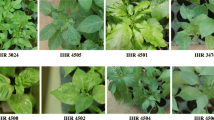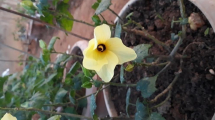Summary
Turnip mosaic virus (TuMV) is the most important virus of commercially grown cole crops in many Asian countries, affecting both yield and quality. TuMV-infected Chinese cabbage becomes unmarketable because of the presence of black spots and necrosis often induced by the virus. Resistance breeding is complicated by the existence of five strains of the virus, one of which was discovered in 1985 for the first time in Taiwan. Resistance to strains C1 to C3 is readily available among the Chinese cabbage germplasm at AVRDC, whereas resistance to strains C4 and C5 is rarely found. To elucidate the inheritance of resistance to TuMV, P1, P2, F1, F2 and BC1 generations of crosses between the resistant line ‘0–2’ and three susceptible lines, ‘E-7’, ‘E-9’ and ‘FL-9’, were inoculated with strains C4 and C5. Segregation ratios obtained by visual observation and enzyme-linked immunosorbent assay (ELISA) indicate that two recessive genes confer resistance to both TuMV-C4 and TuMV-C5.
Similar content being viewed by others
References
Ahlawat, Y.S. & V.V. Chenulu, 1984. Radish mosaic: a new disease caused by TuMV in India. Trop. Agric. 61: 188–192.
Anonymous, 1976. Mosaic viruses from crucifers in the vincinity of Sian. Acta Microbiol. Sin. 16: 136–141.
Asian Vegetable Research and Development Center, 1984. 1982 Progress Report. Shanhua, Tainan, R.O.C.
Asian Vegetable Research and Development Center, 1985. 1983 Progress Report. Shanhua, Tainan, R.O.C.
Asian Vegetable Research and Development Center, 1987a. 1984 Progress Report. Shanhua, Tainan, R.O.C.
Asian Vegetable Research and Development Center, 1987b. 1985 Progress Report. Shanhua, Tainan, R.O.C.
Asian Vegetable Research and Development Center, 1988. 1987 Progress Report. Shanhua, Tainan, R.O.C.
Asian Vegetable Research and Development Center, 1990. 1988 Progress Report. Shanhua, Tainan, R.O.C.
Chen, M.J., 1975. Electron microscopic study on mosaic diseases of cruciferous vegetable crops. Plant Protection Bulletin 17: 319–328.
Chiu, W.F. & S.S.Liang, 1963. Further studies on the distribution of viruses causing the kwuting disease of Chinese cabbage in Tientsin and Peking. Acta Phytopathol. Sin. 6: 169–279.
Chiu, W.F., 1988. The economic impact of filamentous plant viruses: China. p. 387–392. In: R.G. Milne (Ed). The Plant Viruses: The filamentous plant viruses. Plenum Press, New York and London.
Choi, J.K., N. Matsuyama & S. Wakimoto, 1980. Comparative studies on biological and serological properties of turnip mosaic virus isolates. J. Fac. Agric. Kyushu Univ. 25: 15–23.
DelRosario, M.S., T.T. Reyes & A.R. Salgado, 1966. Mosaic virus on pechay in the Philippines. Philipp. Agric. 50: 213–227.
Green, S.K., 1991. Integrated control of virus diseases of vegetables in Taiwan. Proceedings of the International Workshop on the Implementation of Integrated Control of Virus Diseases of Important Crops. April 9–14, Taichung, Taiwan. Food and Fertilizer Technology Center for the ASPAC region. FFTC Supplement 1: 35–68.
Green, S.K. & T.C.Deng, 1985. Turnip mosaic virus strains in cruciferous hosts in Taiwan. Plant Disease 69: 28–31.
Herscheid, B. & S. Green, 1990. Differenzierung von TuMV Stäumen mit poly-und monoklonalen Antikörpern. Mitteilungen aus der Biologischen Bundesanstalt für Land und Forstwirtschaft, Berlin Heft 266: 477.
Ke, C., K.B. Li, H. Chen, Y.Z. Chen, L.J. Zhang & S.Y. Zhang, 1983. Studies on the purification of viruses causing the mosaic disease of cruciferous vegetables in Fuzhou. Fujian Agric. Sci. Technol. 6: 18–20.
Lee, H.Y. & V. Lee, 1973. Studies on physical protection in relation to development of turnip mosaic virus infection on Chinese white cabbage. Agric. Hong Kong 1: 161–164.
Li, L., 1989. Identification of turnip mosaic virus strains on oilseed rape. Euphytica 2: 51–56.
Lim, W.L., S.H. Wang & O.C. Ng, 1978. Resistance in Chinese cabbage to turnip mosaic virus. Plant Dis. Rep. 62: 660–662.
Ling, L. & J.Y. Yang, 1940. A mosaic disease of rape and other cultivated crucifers in China. Phytopathology 30: 338–342.
Pandey, B.P. & J. Mohan, 1986. Inhibition of turnip mosaic virus by plant extracts. Indian Phytopathol. 39: 489–491.
Provvidenti, R., 1980. Evaluation of Chinese cabbage cultivars from Japan and the People's Republic of China for resistance to turnip mosaic virus and cauliflower mosaic virus. J. Amer. Soc. Hort. Sci. 105(4): 571–573.
Provvidenti, R., R.W. Robinson & J.W. Shail, 1979. Chicory: A valuable source of resistance to turnip mosaic virus for endive and escarole. J. Amer. Soc. Hort. Sci. 104: 726–728.
Shattuck, V.I. & L.W. Stobbs, 1987. Evaluation of rutabaga cultivars for turnip mosaic virus resistance and inheritance of resistance. HortScience 22: 935–937.
Sheen, T.F. & H.L. Wang, 1982. Breeding radish for resistance to turnip mosaic virus I. Screening for TuMV resistance and other characteristics in F1. Natl. Sci. Counc. Monthly, R.O.C. 10: 972–980.
Tamura, M., 1969. Inhibition of turnip mosaic virus by the juice extracted from Japanese black pine (Pinus thunbergii Parl.). Ann. Phytopathol. Soc. Japan 35: 260–264.
Tomlinson, J.A., 1970. Turnip mosaic virus. CMI/AAB Descriptions of Plant Viruses. No. 8 Commonwealth Mycol. Inst., Kew, England. 4 p.
Walkey, D.G.A. & M.J.W. Webb, 1978. Internal necrosis is stored while cabbage caused by turnip mosaic virus. Ann. Appl. Biol. 89: 435–441.
Walkey, D.G.A. & D.A.C. Pink, 1988. Reactions of white cabbage (Brassica oleracea var. capitata) to four different strains of turnip mosaic virus. Ann. Appl. Biol. 112: 273–284.
Walsh, J.A., 1989. Genetic control of immunity to turnip mosaic virus in winter oilseed rape (Brassica napus ssp. oleifera) and the effect of foreign isolates of the virus. Ann. Appl. Biol. 115: 89–99.
Walsh, J.A. & J.A. Tomlinson, 1985. Viruses affecting winter oilseed rape (Brassica napus ssp. oleifera). Ann. Appl. Biol. 107: 485–495.
Xu, L.S., H.S. Niu, S.Z. Huang, L. Zheng & M.Q. Wang, 1983. Identification of the turnip mosaic virus, Cong-Ming cabbage isolate-TPMVCM. Acta Phytopathol. Sin. 13: 21–30.
Yoshii, H., 1963. On the strain distribution of turnip mosaic virus. Ann. Phytopathol. Soc. Japan 28: 221–227.
Zhang, X.H., S.Z. Zhao, W.G. Cai & B. Tian, 1976. The inhibitory effects of oil emulsion on the aphid transmission of non-persistent plant viruses. Acta Microbiol. Sin. 16: 142–147.
Zink, F.W. & J.E. Duffus, 1973. Inheritance and linkage of turnip mosaic virus and downy mildew (Bremia lactucae) reaction in Lactuca serriola. J. Amer. Soc. Hort. Sci. 98: 49–51.
Author information
Authors and Affiliations
Rights and permissions
About this article
Cite this article
Yoon, J.Y., Green, S.K. & Opeña, R.T. Inheritance of resistance to turnip mosaic virus in Chinese cabbage. Euphytica 69, 103–108 (1993). https://doi.org/10.1007/BF00021732
Received:
Accepted:
Issue Date:
DOI: https://doi.org/10.1007/BF00021732




